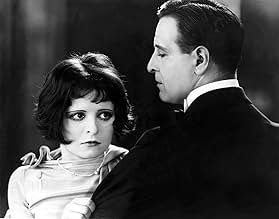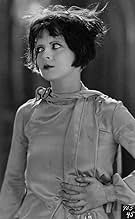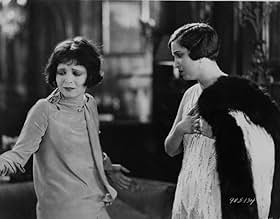अपनी भाषा में प्लॉट जोड़ेंA young girl becomes a "flapper", defying her parents and the community.A young girl becomes a "flapper", defying her parents and the community.A young girl becomes a "flapper", defying her parents and the community.
- निर्देशक
- लेखक
- स्टार
- पुरस्कार
- कुल 2 जीत
फ़ीचर्ड समीक्षाएं
Dancing Mothers is unique in two ways...its ending and showing how women have minds and opinions of their own. While most Hollywood Melodramas of this period had happy, "Pollyanna-ish" endings...Dancing Mothers strays in a most realistic and refreshing way. The Mother (Alice Joyce), tired of being taken for granted, goes out on her own and leaves her selfish daughter (Clara Bow) and husband (Norman Trevor) behind. an ending that todays audiences do not have a hard time swallowing, but audiences of the 1920's expected everything to be tied up in pretty Hollywood ribbons and all made good. And bravo for those who chose to have a woman hold her own and stand up for herself and not give in to what societal norms would dictate. Strong women were not too very typical in the silent era.
Dancing Mothers is a rather dull film except for the vivacious Clara Bow playing "Kittens." Also of interest are the truly ugly sets (check out the hideous pirate-themed nightclub) and the great women's clothes. Clara Bow wears some really bizarre outfits as the jazz baby who sets her sights on Conway Tearle, who plays a "famed lady killer." Tearle is old and dull but was a star in 1926. Alice Joyce is the nominal star. She was billed as "the madonna of the screen," but shows little vitality here as the mother who decides to "live." Dorothy Cumming (whose named is misspelled as "Cummings" in the credits) is good as Mazzy, and Leila Hyams, Donald Keith, Norm Trevor, and Eleanor Lawson round out the supporting cast. Worth seeing for the always-good Clara Bow and for the shocking ending. The whole film seemingly leads up to the conventional ending, but then takes a different route. Dancing Mothers was a big hit in 1926 and helped make Bow one of the biggest stars of the last 20s.
This little melodrama concerns a mother and her daughter falling for the same man. Mum's been the good little "stay-at-home" while her daughter and husband do the town. But Mum gets her revenge! Alice Joyce is very good as mum, and the ending is quite politically subversive - but it is the wonderful Clara Bow who steals the picture. Her vitality, as a little flapper, is mind-blowing, her beauty unsurpassed, and her gowns magnificent. Worth seeing just for the scene on the couch when Clara lies back laughing amongst the cushions - it'll make your heart race.
A typical 'saucy' 20's comedy with a rather innocuous story hiding behind a racy title. Everybody in it is filthy rich (both the Westcourt family and dissolute playboy Gerald Naughton have butlers) and there's plenty of dancing but little else when they get their partners back home.
The use in the title of the plural belies the fact that the plot centres on just one mother: Ethel Westcourt, played by Alice Joyce. (We do not see how her friend Mrs Mazzarene, played by Dorothy Cumming, spends her nights out, but her story - as well as Naughton's - would doubtless have been far naughtier than Ethel's.)
If Ethel's daughter Kittens (played by Clara Bow with an infectious kinetic charm the character would otherwise largely have lacked) had kept her trap shut in the incredible climactic scene in Naughton's lair where most of the cast's paths eventually collide, Ethel would not have been forced to call the bluff of both Kittens and her straying, tombstone-faced banker father Hugh (played by Norman Trevor) in the abrupt unexpected ending, which could only have been possible if Ethel had enjoyed considerable financial means of their own.
The use in the title of the plural belies the fact that the plot centres on just one mother: Ethel Westcourt, played by Alice Joyce. (We do not see how her friend Mrs Mazzarene, played by Dorothy Cumming, spends her nights out, but her story - as well as Naughton's - would doubtless have been far naughtier than Ethel's.)
If Ethel's daughter Kittens (played by Clara Bow with an infectious kinetic charm the character would otherwise largely have lacked) had kept her trap shut in the incredible climactic scene in Naughton's lair where most of the cast's paths eventually collide, Ethel would not have been forced to call the bluff of both Kittens and her straying, tombstone-faced banker father Hugh (played by Norman Trevor) in the abrupt unexpected ending, which could only have been possible if Ethel had enjoyed considerable financial means of their own.
To see the kind of radiance one generally only finds in Edie
Sedgwick (in her might-as-well-be-silent Warhol movies), check
out the scene with racy Clara Bow in a fatcat's apartment while
he's away, swilling his liquor and kicking up her heels on his
couch. Literally. (Was this scene the inspiration for the invasion of
Jerry Lewis' house in THE KING OF COMEDY?) Guzzling gallons
of expensive booze and tracing the line of warmth down her
tummy, Bow is a miraculous fireworks show of life-love and gay
impiety. This is star acting! Our biggest names o\f the moment
seem feeble and class-free by contrast.
Sedgwick (in her might-as-well-be-silent Warhol movies), check
out the scene with racy Clara Bow in a fatcat's apartment while
he's away, swilling his liquor and kicking up her heels on his
couch. Literally. (Was this scene the inspiration for the invasion of
Jerry Lewis' house in THE KING OF COMEDY?) Guzzling gallons
of expensive booze and tracing the line of warmth down her
tummy, Bow is a miraculous fireworks show of life-love and gay
impiety. This is star acting! Our biggest names o\f the moment
seem feeble and class-free by contrast.
क्या आपको पता है
- ट्रिवियाPrints of this film--at 65 minutes--are held by the Library of Congress and the UCLA Film and Television Archives.
- भाव
Mrs. Mazzarene: I warn you--you're playing with fire.
Ethel Westcourt: I'm playing with life!
टॉप पसंद
रेटिंग देने के लिए साइन-इन करें और वैयक्तिकृत सुझावों के लिए वॉचलिस्ट करें
विवरण
- चलने की अवधि1 घंटा 6 मिनट
- ध्वनि मिश्रण
- पक्ष अनुपात
- 1.33 : 1
इस पेज में योगदान दें
किसी बदलाव का सुझाव दें या अनुपलब्ध कॉन्टेंट जोड़ें





























